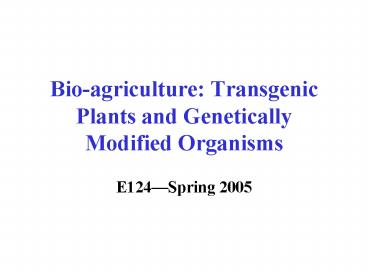Bioagriculture: Transgenic Plants and Genetically Modified Organisms - PowerPoint PPT Presentation
1 / 15
Title:
Bioagriculture: Transgenic Plants and Genetically Modified Organisms
Description:
These are species that are not the direct target of the transgenic crop: ... Insect resistance to Bt crops is considered inevitable. ... – PowerPoint PPT presentation
Number of Views:199
Avg rating:3.0/5.0
Title: Bioagriculture: Transgenic Plants and Genetically Modified Organisms
1
Bio-agriculture Transgenic Plants and
Genetically Modified Organisms
- E124Spring 2005
2
Goals of Bio-agriculture
- Increase resistance to pests (e.g. Bt-cotton).
- Raise tolerance to pesticides (e.g.
Herbicide-tolerant soybean). - Increase market value.
- Reduce dependence on pesticides.
- Herbicides (e.g. Atrazine)
- Fungicides (e.g. Alachlor, Aldicarb)
- Insecticides (e.g. Lindane, Parathion)
3
GMOs in the U.S.
- 75 of the cotton crop.
- 50 of the soy bean crop.
- 20 of the corn crop.
- Other crops (canola, cherry tomatoes, squash,
sugar beets, potatoes).
4
Some GMO Products
- Kelloggs Corn Flakes
- Heinz Baby Cereal
- Nestle Carnation Infant Formula
- Quaker Chewy Granola Bars
- Ultra Slim Fast
- Aunt Jemima Pancake Mix
- Alpo Dry Pet Food
- McDonalds McVeggie Burger
- Old El Paso Taco Shells
5
Environmental Ecological Hazards
- The movement of the transgene itself with
subsequent expression in a different organism or
species. - The transgenic plant itself.
- Non-target hazards associated with the transgene
product outside the plant. - Resistance evolution in the targeted pest
population.
6
Hazards Associated With Gene Movement
- Seed dispersal due to spillage during travel or
from the plant itself . - Horizontal transfer the nonsexual transfer of
genetic material from from one organism to the
genome of another. - Pollen dispersal to other varieties of that crop,
related crops and wild relatives.
7
Hazards Associated With the Whole Plant
- The transgenic plant itself may become an
environmental hazard because the traits it
receives may improve its fitness and ecological
performance. - The addition of a single transgene that improves
some ecological characteristic could increase the
weediness or invasiveness of the species.
8
Non-target Hazards
- These are species that are not the direct target
of the transgenic crop - Beneficial species, including natural enemys of
the pests. - Non-target pests.
- Soil organisms.
- Species of conservation concern.
- Biodiversity, includes species richness.
9
Hazards of Resistance Evolution
- Resistance evolution can occur in pests that are
targeted for control by or associated with a
transgenic crop. - Insect resistance to Bt crops is considered
inevitable. - Virus resistance has not been used extensively,
but many viruses have evolved resistance to
conventional crop resistance. - Fungal and bacterial resistance is not yet
commercially available, but have evolved
resistance within 5 years for conventional
approaches. - Herbicide tolerant transgenic crops are designed
so that weed control is easier, however as weeds
evolve resistance the benefit is lost.
10
Potential Risks to Human Health
- Allergic reactions.
- Compromise human immunity (antibiotic
resistance). - Removal of valuable nutritional substances in
food.
11
Ethical Issues
- Cultural shifts in farming due to the
introduction of terminator seeds. - The anecdotal evidence of allergies to
genetically modified crops. - The lack of an adequate risk assessment
methodology to quantify unintended ecological
consequences. - Resistance of intestinal bacteria to antibiotics.
- The preservation of natural genetic crop-lines.
12
Substantially Equivalent
- Some of the ethical dilemmas concerned with GMOs
are a result of treating genetically modified
crops as being substantially equivalent to
conventional crops. - This has led to issues such as product labeling,
patents, and regulation.
13
Uncertainty theory, in a nut shell
- As we know,
- there are known knowns.
- There are things we know we know.
- We also know
- there are known unknowns.
- That is to say,
- we know there are some things
- we do not know.
- But there are also unknown unknowns,
- the ones we don't know
- we don't know.
- Donald Rumsfeld, U.S. Secretary of Defense
, Iraq Weapons of Mass Destruction Press
Conference
14
The Precautionary Principle
- 1992 Rio Declaration, Where there are threats
of serious or irreversible damage, lack of full
scientific certainty shall not be used as a
reason for postponing cost-effective measures to
prevent environmental damage.
15
The Precautionary Principle (PP) Vs. Science
Based Risk Assessment (RA)
- Type I errors the probability of erroneously
rejecting a valid hypothesis (false negative). - Type II errors the probability of accepting an
invalid hypothesis (false positive). - The PP tries to protect against type I errors and
RA tries to protect against type II errors.

